| Charleston
Gyre |

 |
 |
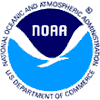 |
February 3, 2003 Most marine fish have
complex life history Eggs and fish larvae die
in many ways. They can starve. They can be eaten. They can be transported
away from suitable habitats. The survivors are those lucky few who get
enough to eat, avoid the myriad of predators, and are transported favorably
by ocean currents. These few larvae then enter juvenile habitats and
must again get enough to eat and avoid predation. After making it through
this early life cycle gauntlet, the surviving fish join the adult population
and reproduce, initiating the cycle again. Determining which factors
dominate early life cycle survival will provide important information
as to the health of fish populations. Bad years could be marked by not
enough food or cold temperatures. Good years could be caused by favorable
winds or few predators. Understanding the factors that affect early
life cycle survival will contribute to NOAA’s mission of building
sustainable fisheries and sustaining healthy coasts. This cruise finds us north of the Charleston Bump studying ichthyoplankton. Why are we working here? The Gulf Stream runs northward along the edge of the southeast United States continental shelf. After passing over the Charleston Bump, the Gulf Stream often veers to the east and then back to the northwest. This veering sets up counter-clockwise rotation, or cyclonic rotation, and deep, nutrient rich water is sucked up towards the surface. The area of semi-permanent cyclonic rotation is termed the “Charleston Gyre” and we are exploring whether the “Charleston Gyre” is a good place for the survival of ichthyoplankton, or fish eggs and larvae. The cool nutrient rich
water that upwells in the center of the “Charleston Gyre”
fuels the growth of single celled plants called phytoplankton (phyto
is the greek root for plant). The plants are food for zooplankton, which
are small animals living in the plankton (zoo is the Greek root for
animal). Marcy Hutchinson, Physiology
and Ecology Technician Some of Marcy’s duties include sorting and identifying zooplankton, acquiring and analyzing chlorophyll samples and help write cruise reports. She’ll be working this summer in a marine protected area in the Dry Tortugas. The thing she likes the
most about her job is the field work and being outdoors. What she doesn’t
like is getting seasick! She decided that if she could be any sea creature
it would be a dolphin. Why? They’re fast, graceful, intelligent
and seem to have a lot of fun. |
| Ph.
843-953-7263 |
Project
Oceanica Dept. of Geology & Environmental Geosciences College of Charleston Charleston, SC 29424 |
Fax
843-953-7850 |

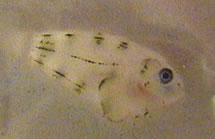 The
planktonic stages of fish, those at the mercy of ocean currents, are
termed ichthyoplankton from the Greek root for fish – ichthyo.
So why is ichthyoplankton important? If all the millions of eggs and
larvae survived to become adults, we would literally be swimming in
fishes. But, all of the eggs and larvae don’t survive, and mortality
during the first year of life typically exceeds 99.99%. In other words,
out of 100,000 eggs spawned, fewer than 10 will survive their first
year of life. Thus, the surviving eggs and larvae are the exception
rather than the rule, and the factors that create the exceptions, the
surviving ichthyoplankton, have very important consequences to adult
fish population.
The
planktonic stages of fish, those at the mercy of ocean currents, are
termed ichthyoplankton from the Greek root for fish – ichthyo.
So why is ichthyoplankton important? If all the millions of eggs and
larvae survived to become adults, we would literally be swimming in
fishes. But, all of the eggs and larvae don’t survive, and mortality
during the first year of life typically exceeds 99.99%. In other words,
out of 100,000 eggs spawned, fewer than 10 will survive their first
year of life. Thus, the surviving eggs and larvae are the exception
rather than the rule, and the factors that create the exceptions, the
surviving ichthyoplankton, have very important consequences to adult
fish population.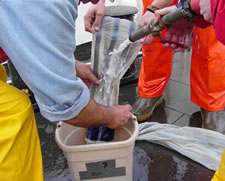
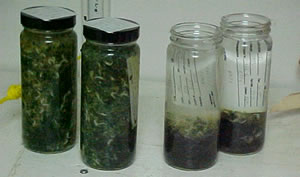 Many different types of animals make up the zooplankton: chaetognaths,
salps, copepods, amphipods, isopods, pteropods, and many more. Zooplankton
in turn is larval fish food. So, the “Charleston Gyre” may
be a good place for the survival of ichthyoplankton because of all the
food. However, fish larvae are also food themselves, and the “Charleston
Gyre” may be a good place for the predators of fish larvae (for
example chaetognaths and ctenophores). Finally, once formed, the “Charleston
Gyre” moves with the Gulf Stream along the edge of the shelf and
another “Gyre” forms in its place. What happens to the water
and fish larvae in a “Charleston Gyre” is unclear. Ichthyoplankton
may be trapped and not able to get to juvenile habitats. Alternatively,
the “Charleston Gyre” may move along the shelf and supply
fish larvae to their appropriate juvenile habitats. In the end, we hope
the data we gather will allow us to discover if the “Charleston
Gyre” is a good place for fish larvae.
Many different types of animals make up the zooplankton: chaetognaths,
salps, copepods, amphipods, isopods, pteropods, and many more. Zooplankton
in turn is larval fish food. So, the “Charleston Gyre” may
be a good place for the survival of ichthyoplankton because of all the
food. However, fish larvae are also food themselves, and the “Charleston
Gyre” may be a good place for the predators of fish larvae (for
example chaetognaths and ctenophores). Finally, once formed, the “Charleston
Gyre” moves with the Gulf Stream along the edge of the shelf and
another “Gyre” forms in its place. What happens to the water
and fish larvae in a “Charleston Gyre” is unclear. Ichthyoplankton
may be trapped and not able to get to juvenile habitats. Alternatively,
the “Charleston Gyre” may move along the shelf and supply
fish larvae to their appropriate juvenile habitats. In the end, we hope
the data we gather will allow us to discover if the “Charleston
Gyre” is a good place for fish larvae. 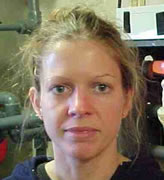 Marcy actually works for a company called ORISE and is contracted by
NOAA. She got her Bachelor’s degree in biology with a concentration
in marine biology. She went on to get her Master’s degree, also
in biology. She said she had always been in interested in the ocean
but chose her career for the “fun factor”.
Marcy actually works for a company called ORISE and is contracted by
NOAA. She got her Bachelor’s degree in biology with a concentration
in marine biology. She went on to get her Master’s degree, also
in biology. She said she had always been in interested in the ocean
but chose her career for the “fun factor”.